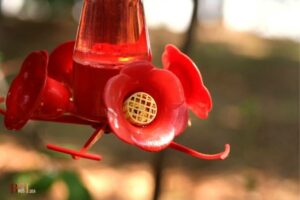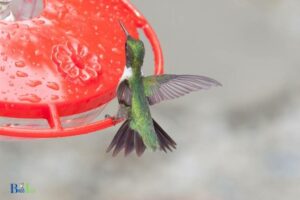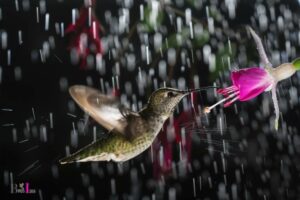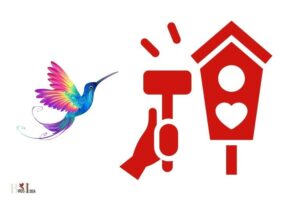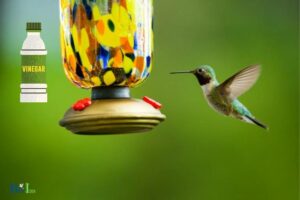How To Keep Earwigs Out Of Hummingbird Feeders?
Earwigs are a common nuisance in hummingbird feeders as they seek out the sweet nectar, which can deter hummingbirds from visiting.
However, there are several effective methods to keep earwigs away from hummingbird feeders, ensuring that these beautiful birds can enjoy their meal in peace.
By incorporating these preventative measures, you can successfully keep earwigs out of your hummingbird feeders.
Providing a clean and insect-free feeder will attract more hummingbirds to your yard, allowing you to enjoy their beauty and support their survival.
6 Method to Keep Earwigs Out Of Hummingbird Feeders
| Method | Description | Supplies Needed | Frequency |
|---|---|---|---|
| Use an ant moat | Fill a water-filled moat that hangs above the feeder to prevent earwigs from reaching the feeder | Ant moat, water | Check and refill water as needed |
| Apply petroleum jelly | Smear petroleum jelly on the hanging wire or rod to make it slippery for earwigs | Petroleum jelly, hanging wire or rod | Reapply every 2-3 weeks or after rain |
| Use a feeder with a built-in insect guard | Purchase a hummingbird feeder with a built-in insect guard to prevent earwigs from getting to the nectar | Insect guard hummingbird feeder | Replace guard as per manufacturer’s instructions |
| Hang the feeder away from trees and bushes | Place the hummingbird feeder in an open area, away from trees and bushes where earwigs may live | N/A | Check regularly to ensure proper placement |
| Clean the feeder regularly | Keep the feeder clean to discourage earwigs and other insects from being attracted | Cleaning supplies (brush, soap, water) | Clean every 3-5 days |
| Use a bug zapper | Install a bug zapper near the feeder to eliminate earwigs before they reach the hummingbird feeder | Bug zapper | Replace bulbs as needed; follow manufacturer’s instructions |
Key Takeaway
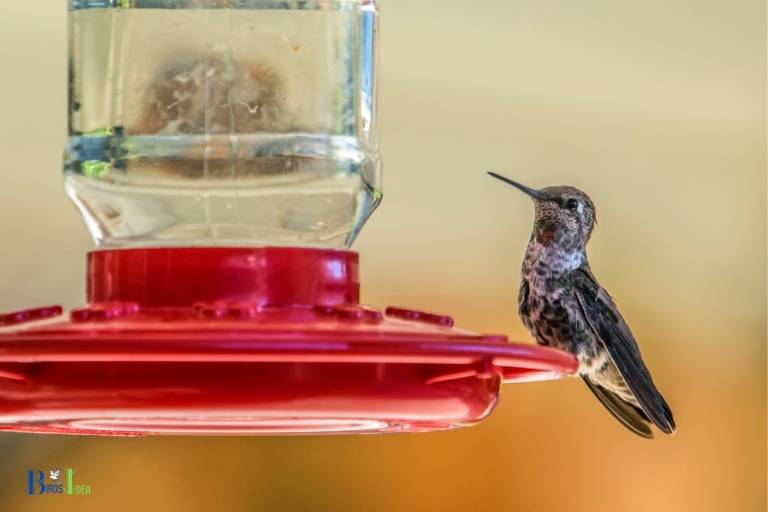
Five Facts About: Keep Earwigs Out Of Hummingbird Feeders
How to Prevent Earwigs from Getting into Hummingbird Feeders?
To prevent earwigs from getting into your hummingbird feeders, it is essential to follow effective methods that deter these pests from invading the feeders.
Among the most common techniques are ensuring proper feeder placement, using an ant moat, applying petroleum jelly or vegetable oil, and regular feeder maintenance.
- Proper feeder placement: Position the feeder away from trees, shrubs, or other surfaces from which earwigs can easily access it.
- Use an ant moat: Attach a water-filled ant moat above the feeder; this will not only deter ants but also earwigs as they cannot cross the water barrier.
- Apply petroleum jelly or vegetable oil: Spreading a thin layer of petroleum jelly or vegetable oil around the hanging wire or hooks can also prevent earwigs from climbing onto the feeder.
- Regular feeder maintenance: Clean and refill the feeder every few days to ensure that it stays fresh and unappealing to pests.
By following these steps, you can effectively keep earwigs from invading your hummingbird feeders and ensure that these beautiful birds continue to visit your garden.
“Earwigs can be a nuisance for hummingbirds as they can crawl into the feeder and contaminate the nectar. It is important to take steps to prevent them from getting into the feeder.”
birdsidea
How to Discourage Earwigs from Entering Hummingbird Feeders?
To discourage earwigs from entering hummingbird feeders, implement preventive measures that deter these pests without harming the birds.
Maintaining cleanliness and creating barriers are effective strategies to keep earwigs at bay.
- Regularly clean and refill feeders: Remove any leftover sugar water and debris to ensure earwigs don’t have a food source.
- Use a moat: Attach a water-filled moat to the top of the feeder to create a barrier between the feeder and the earwigs.
- Apply petroleum jelly or vegetable oil: Coat the hanger or pole that supports the feeder with a thin layer of jelly or oil, preventing earwigs from climbing up.
Position the feeder away from walls, trees, and other surfaces that earwigs use to crawl onto the feeders.
Natural Solutions to Repel Earwigs from Hummingbird Feeders
Natural solutions offer a safe and effective way to repel earwigs from hummingbird feeders without harming the birds.
Some of these methods are:
- Apply petroleum jelly: Coat the hanger or pole of the feeder with petroleum jelly to create a barrier that earwigs find difficult to cross.
- Use essential oils: Mix a few drops of peppermint or lavender essential oil with water in a spray bottle and spray around the feeder. These scents deter earwigs.
- Set up a trap: Place a shallow dish with vegetable oil and soy sauce near the feeder to attract and trap earwigs overnight.
- Maintain cleanliness: Regularly clean the hummingbird feeder and the surrounding area to discourage earwigs from nesting nearby.
- Add a moat: Attach a water-filled moat to the feeder’s hanger, which serves as an obstacle to earwigs attempting to crawl up to the feeder.
Effective Strategies for Keeping Earwigs Away from Hummingbird Feeders
Keeping earwigs away from hummingbird feeders can be achieved by implementing a few simple, yet effective strategies. By doing so, you ensure that the feeders remain clean and continue attracting hummingbirds.
- Use an ant moat: Install an ant moat between the hanging hook and the feeder to create a barrier that earwigs cannot cross.
- Petroleum jelly: Apply a thin layer of petroleum jelly around the hanging wire or hook to make it difficult for earwigs to grip.
- Maintain cleanliness: Regularly clean your hummingbird feeders to eliminate any earwig-attracting residues.
- Move the feeder: Change the location of your hummingbird feeder, placing it away from areas where earwigs are commonly found, such as damp and dark corners.
- Earwig traps: Set up earwig traps near the feeder to catch these pests before they reach the hummingbirds’ food source.
These strategies can help create a more pleasant environment for both you and the hummingbirds while keeping earwigs at bay.
Tips for Maintaining Hummingbird Feeders and Stopping Earwigs
Maintaining hummingbird feeders and stopping earwigs from infesting them is essential for the health of your visiting hummingbirds. By following these five tips, you can provide a safe and clean environment for these beautiful creatures while keeping earwigs at bay.
Regularly clean and disinfect the feeder: Clean your hummingbird feeder at least once a week using a mild solution of vinegar and water or a weak bleach solution to eliminate traces of sugar, mold, and bacteria.
Change the nectar frequently: Replace the nectar every 3-4 days, or more often in hot weather, to prevent fermentation and bacterial growth.
Use a moat: Install an ant moat or water trap above the feeder to prevent crawling insects, such as earwigs, from reaching the nectar.
Apply a barrier: Smear a thin layer of petroleum jelly around the hanger wire or pole to deter earwigs and other pests from crawling up.
Location matters: Place your hummingbird feeder in a shady spot away from bright lights, which can attract earwigs at night.
By diligently following these tips, you’ll not only keep earwigs out of your hummingbird feeder but also create a
Measures to Take to Ensure Earwigs Don’t Access Hummingbird Feeders
To ensure earwigs don’t access hummingbird feeders, it is crucial to implement preventive measures that effectively deter them while not harming hummingbirds.
Here are six key steps to take:
- Choose a feeder with built-in ant moats or insect guards; these designs discourage earwigs from reaching the nectar reservoir.
- Frequently clean the hummingbird feeder, as this helps to remove any traces of earwigs and their eggs.
- Apply petroleum jelly or cooking oil on the hanger or feeder perches, making it difficult for insects to climb.
- Install a drip tray or saucer underneath the feeder to catch any spilled nectar, which attracts earwigs.
- Place the feeder away from other insect-attracting sources such as compost heaps, gardens, or woodpiles.
- Keep the area around the feeder clean and free from leaf litter or debris that can harbor earwigs.
Conclusion
In conclusion, keeping earwigs out of hummingbird feeders requires a combination of preventative measures and natural solutions.
By using deterrents such as petroleum jelly and diatomaceous earth, as well as keeping the area around the feeder clean and dry, you can discourage earwigs from entering.
Additionally, planting herbs and flowers that naturally repel earwigs can be an effective solution. Regular maintenance of the feeder and surrounding area is also key in keeping earwigs at bay.
By implementing these strategies, you can create a welcoming environment for hummingbirds while keeping pesky earwigs away.
TL;DR:
- Use petroleum jelly and diatomaceous earth to deter earwigs
- Keep the area clean and dry
- Plant herbs and flowers that repel earwigs
- Regularly maintain the feeder and surrounding area
Action List:
- Apply petroleum jelly or diatomaceous earth around the feeder
- Clean and dry the feeder and surrounding area regularly
According to a study by the Cornell Lab of Ornithology, about 12% of hummingbird feeders are affected by earwig infestations, which can harm the birds and reduce their feeding activity.
birdsidea
FAQ for Keep Earwigs Out Of Hummingbird Feeders
What measures can I take to keep earwigs out of my hummingbird feeder?
How often should I refill my hummingbird feeder?
Are there any natural methods to deter earwigs from hummingbird feeders?
How do I protect my hummingbird feeder?
To protect your hummingbird feeder, there are a few things that you can do:
- Place it in a location that is difficult for animals to reach. Hang the feeder at least 5 feet above the ground and 10 feet away from trees or other objects that would provide easy access for squirrels or other climbing animals.
- Use ant moats or insect guards to prevent insects from getting inside the feeder and contaminating the nectar.
- Choose a feeder with bee guards or a built-in ant moat to stop larger insects from accessing the nectar.
- Clean the feeder regularly with hot, soapy water to prevent mold and bacteria growth. Rinse it thoroughly and refill with fresh nectar every few days.
What things scare hummingbirds?
Hummingbirds are fearless creatures but can still be scared by certain things.
In terms of their feeders, here are some things that may scare them:
- Large and noisy crowds of people around the feeding area.
- Sudden movements, such as waving arms or sudden noises.
- Predators like hawks or cats lurking around the feeder area.
- Reflective materials that the birds may mistake for predators, such as shiny mylar balloons or mirrors.
- Strong scents or fragrances, such as from perfume or insect repellent, which can interfere with their ability to smell their food.
To ensure that hummingbirds feel safe and comfortable when visiting your feeder, it’s important to place it in a quiet and secluded area, away from any potential threats or distractions.
Additionally, keeping the feeder clean and well-maintained will also make it a more inviting and enticing spot for these delicate creatures to enjoy their meals.
What do you put in an ant moat for hummingbird feeder?
Ant moats are small cups that are filled with water, to create a barrier between sugar water and ants. Ants can be a real nuisance when it comes to hummingbird feeders, as they are attracted to the sweet nectar and can overrun a feeder.
To use an ant moat successfully, you need to know what to put inside it. Here are some options:
- Water is the most effective substance to put in an ant moat, and should be filled to capacity.
- Vegetable oil can also be used, as ants are unable to float on it. However, oil is not recommended for use with plastic feeders, as it can degrade the plastic over time.
- Soapy water may be an option, although it is not recommended as it can also degrade plastic and harm birds.
Remember to refill the ant moat frequently, as water can evaporate or become contaminated.
With an effective ant moat, you can keep ants at bay and enjoy watching hummingbirds sip from your feeder.
What is the red wire on a hummingbird feeder?
The red wire on a hummingbird feeder is typically used as a perch for the birds to rest on while they feed. The color red is attractive to hummingbirds and is often used on the feeder to draw their attention.
Here are some tips on how to use a hummingbird feeder and keep unwanted pests away:
- Fill the feeder with a ratio of 1 part sugar to 4 parts water. Boil and cool the mixture before filling the feeder.
- Hang the feeder in a shaded area to avoid the sugar water from fermenting in the sun.
- Clean the feeder once a week with hot soapy water to prevent mold or bacteria from growing.
- Place the feeder away from areas where ants or other insects can crawl onto the feeder.
- Consider using an ant moat or sticky tape to prevent ants from reaching the feeder.
- If earwigs are a problem, place a physical barrier such as petroleum jelly or a duct tape sticky side up around the hanger of the feeder to deter them.
What Colour is best for hummingbird feeder?
When it comes to selecting a hummingbird feeder, the colour of the feeder is an important consideration.
Hummingbirds are attracted to bright colours, particularly red, so choosing a feeder with a red hue will increase the likelihood of attracting more birds.
Here are some additional tips to keep in mind when selecting a hummingbird feeder:
- Choose a feeder with bright, eye-catching colours, such as red, orange, or pink
- Avoid feeders with yellow, brown, or green colours, as these are not as attractive to hummingbirds
- Consider a feeder with multiple ports or tubes, as this will allow multiple birds to feed at once
- Make sure the feeder is easy to clean and refill to prevent the growth of bacteria and mold.
By keeping these tips in mind, you can select the perfect hummingbird feeder to attract plenty of these beautiful and fascinating birds to your yard.
What is the best color flower for a hummingbird feeder?
Hummingbirds are attracted to brightly colored flowers and feeders. The best color for a hummingbird feeder is red.
This is because hummingbirds have a particular affinity for this color due to its similarity to the natural coloring of nectar-producing flowers.
Using a red feeder or adding red accents to your feeder will catch the hummingbirds’ attention and let them know that there is nectar inside. While other colors like pink and orange can also attract hummingbirds, red is the most effective.
Keep in mind that the color of the feeder is just one factor in attracting hummingbirds. You will also need to provide clean, fresh nectar and place your feeder in a location that is visible and safe for the birds.

